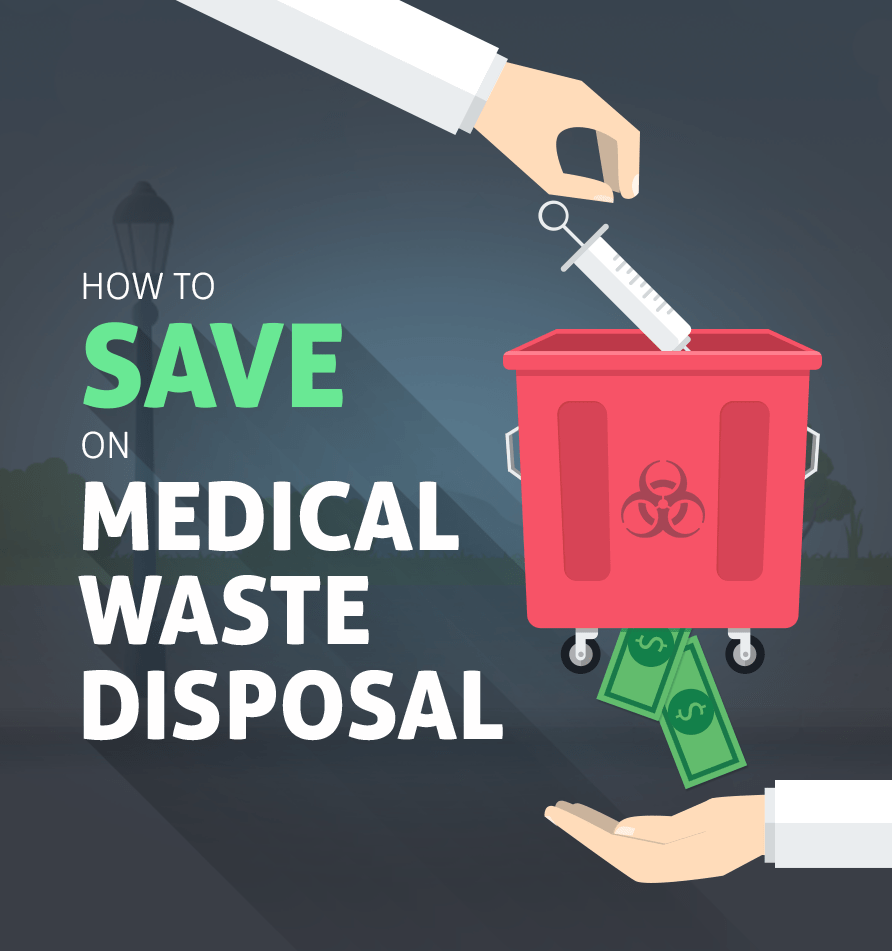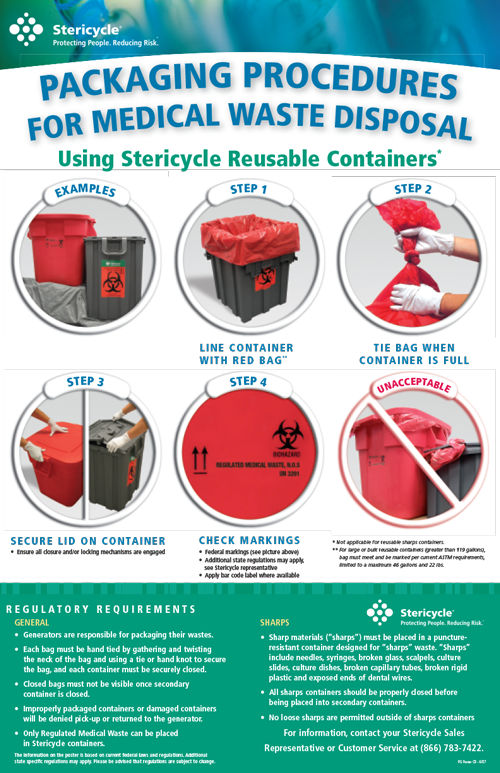Strategic Medical Waste Disposal Solutions: Encouraging Safety and Sustainability
Wiki Article
Compliance and Rules for Medical Garbage Disposal
Compliance and policies for clinical garbage disposal play an essential duty in making certain the safety and security and well-being of both health care experts and the public. Proper management of medical waste is important to avoid the spread of infections, secure the atmosphere, and maintain public wellness. This calls for adherence to certain standards and protocols established forth by governing agencies and bodies. These regulations encompass different facets, consisting of the category and segregation of medical waste, appropriate storage space and handling treatments, as well as transport and disposal methods. By adhering to these regulations, medical care centers can decrease the threat of contamination and potential harm to people and the atmosphere. This write-up will certainly discover the importance of compliance and provide an introduction of the crucial policies regulating clinical garbage disposal.Value of Compliance
The significance of conformity with laws for medical garbage disposal can not be overemphasized. Proper disposal of medical waste is essential for making sure the safety and security and wellness of health care employees, patients, and the public. Clinical waste, which consists of things such as made use of needles, infected gloves, and biomedical waste, can pose significant wellness dangers if not taken care of and gotten rid of effectively.Compliance with policies makes sure that clinical waste is managed in such a way that decreases the capacity for direct exposure to damaging materials and contagious diseases - medical waste removal service. It helps prevent the spread of infections, such as HIV, liver disease B and C, and other bloodborne microorganisms. Conformity also plays a crucial function in safeguarding the environment by protecting against contamination of water sources, soil, and air
Failing to abide by regulations can result in extreme effects for medical care centers, including penalties, lawsuit, and damage to their track record. Furthermore, non-compliance might jeopardize the health and security of medical care employees, people, and the neighborhood.
Conformity with policies for clinical garbage disposal needs adherence to details standards and procedures. These may consist of appropriate segregation, packaging, labeling, and storage of medical waste. It also entails making use of approved disposal approaches, such as landfilling, incineration, or autoclaving, relying on the type of waste.
Regulative Agencies and Bodies
Regulatory firms and bodies play an important role in supervising conformity with guidelines for clinical garbage disposal. These companies are in charge of setting methods, standards, and standards to make certain the appropriate and safe handling of clinical waste. They check and impose conformity to shield public health and wellness and the atmosphere.One of the most prominent governing agencies in the United States is the Environmental Protection Firm (EPA) The EPA is in charge of regulating the storage, transport, treatment, and disposal of medical waste. They develop guidelines for waste generators, carriers, and treatment facilities to adhere to, guaranteeing that all essential preventative measures are taken to prevent the spread of illness and contamination.
Another crucial governing body is the Occupational Security and Health Administration (OSHA) OSHA establishes laws and criteria to secure employees from work-related threats, consisting of those pertaining to clinical waste. WasteX Medical Waste Disposal. They provide guidelines for the safe handling and disposal of clinical waste to protect staff members in health care facilities
In addition to these government companies, private states also have their very own governing bodies that oversee clinical garbage disposal. These firms might have their very own certain guidelines and needs that need to be adhered to.

Classification and Segregation of Medical Waste
To ensure correct management of clinical waste, it is necessary to categorize and segregate it according to developed protocols and standards. medical waste removal service. Classification and partition play a crucial duty in minimizing the danger of infection, safeguarding the setting, and making certain the security of health care workers and the general publicClinical waste is categorized right into various groups based upon its potential danger degree. These groups consist of contagious waste, pathological waste, sharps waste, pharmaceutical waste, chemical waste, and radioactive waste. Each group needs specific handling, transport, disposal, and storage methods to reduce the threat of direct exposure and contamination.
Partition of medical waste entails separating different kinds of waste at the resource. This process guarantees that waste with different hazard levels is not mixed, minimizing the potential for cross-contamination and making disposal treatments much more efficient. Appropriate partition is attained through using color-coded tags and containers, which assist healthcare employees and waste administration employees handle each type and recognize of waste properly.
Along with category and segregation, healthcare centers have to additionally comply with local, state, and federal regulations regarding clinical waste administration. These policies outline certain needs for storage space, transport, treatment, and last disposal of medical waste, ensuring conformity and maintaining public wellness and security.
Appropriate Storage Space and Handling Procedures
Proper storage space and managing procedures play a vital role in making certain the certified and secure management of clinical waste. Clinical waste, which consists of things such as used syringes, polluted handwear covers, and ran out medications, can position serious health and ecological dangers otherwise managed properly. Consequently, it is essential for healthcare facilities and various other generators of clinical waste to implement strict storage and managing protocols.
To start with, clinical waste ought to be stored in resilient, watertight containers that are especially designed for this objective. These containers ought to be classified with the global biohazard icon and the words "clinical waste" to clearly suggest the components. In addition, the containers need to be maintained safely shut to protect against any kind of prospective leak or spillage.
In addition, it is necessary to set apart various sorts of clinical waste to protect against cross-contamination. Sharps, such as scalpels and needles, need to be kept in puncture-resistant containers to minimize the danger of injuries - WasteX Medical Waste Disposal. Chemical waste, such as anti-bacterials and solvents, must be stored individually from other kinds of medical waste to protect against harmful exposures or chemical responses

Transport and Disposal Methods
Medical care facilities need to make certain the safe transportation and appropriate disposal of their clinical waste to abide by regulations and shield public health. Transportation and disposal methods play an essential duty in stopping the spread of transmittable conditions and minimizing the environmental influence of clinical waste.
To transfer clinical waste, healthcare facilities should utilize watertight and puncture-resistant containers that are classified with the biohazard icon. These containers need to be firmly secured to stop any kind of leakage throughout transportation. Furthermore, healthcare facilities need to develop methods for the transport procedure, consisting of making use of dedicated lorries and trained employees.
Once the clinical waste gets to the disposal center, it undergoes numerous approaches of therapy. One typical technique is incineration, which includes burning the waste at heats to ruin microorganisms and decrease the volume of waste. An additional method is autoclaving, which uses vapor and stress to sterilize the waste. After treatment, the waste is usually sent out to a garbage dump or a waste-to-energy center for last disposal.
It is vital for health care centers to deal with qualified and permitted waste monitoring business to make certain appropriate transport and disposal of clinical waste. These business have the know-how and resources to manage medical click over here now waste safely and in conformity with laws.
Conclusion
Finally, compliance with laws for clinical garbage disposal is of utmost significance to guarantee public health and safety. Regulatory firms and bodies play a critical role in implementing these regulations. Proper classification and partition of medical waste, along with following proper storage and dealing with procedures, are important to prevent contamination and the spread of illness. Ample transportation and disposal methods should be implemented to reduce environmental effects. In general, adherence to conformity and laws is needed to effectively handle clinical waste.Medical waste, which includes things such as utilized needles, infected gloves, and biomedical waste, can pose serious health risks if not handled and disposed of effectively.
These groups include infectious waste, pathological waste, sharps waste, pharmaceutical waste, chemical waste, and contaminated waste.Segregation of clinical waste entails separating various types of waste at the source. Correct partition is attained via the use of color-coded labels and containers, which help medical care workers and waste monitoring employees identify and take care of each type of waste properly.
Chemical waste, such as solvents and disinfectants, must be kept independently from various other types of medical waste to avoid dangerous exposures or chemical reactions.
Report this wiki page